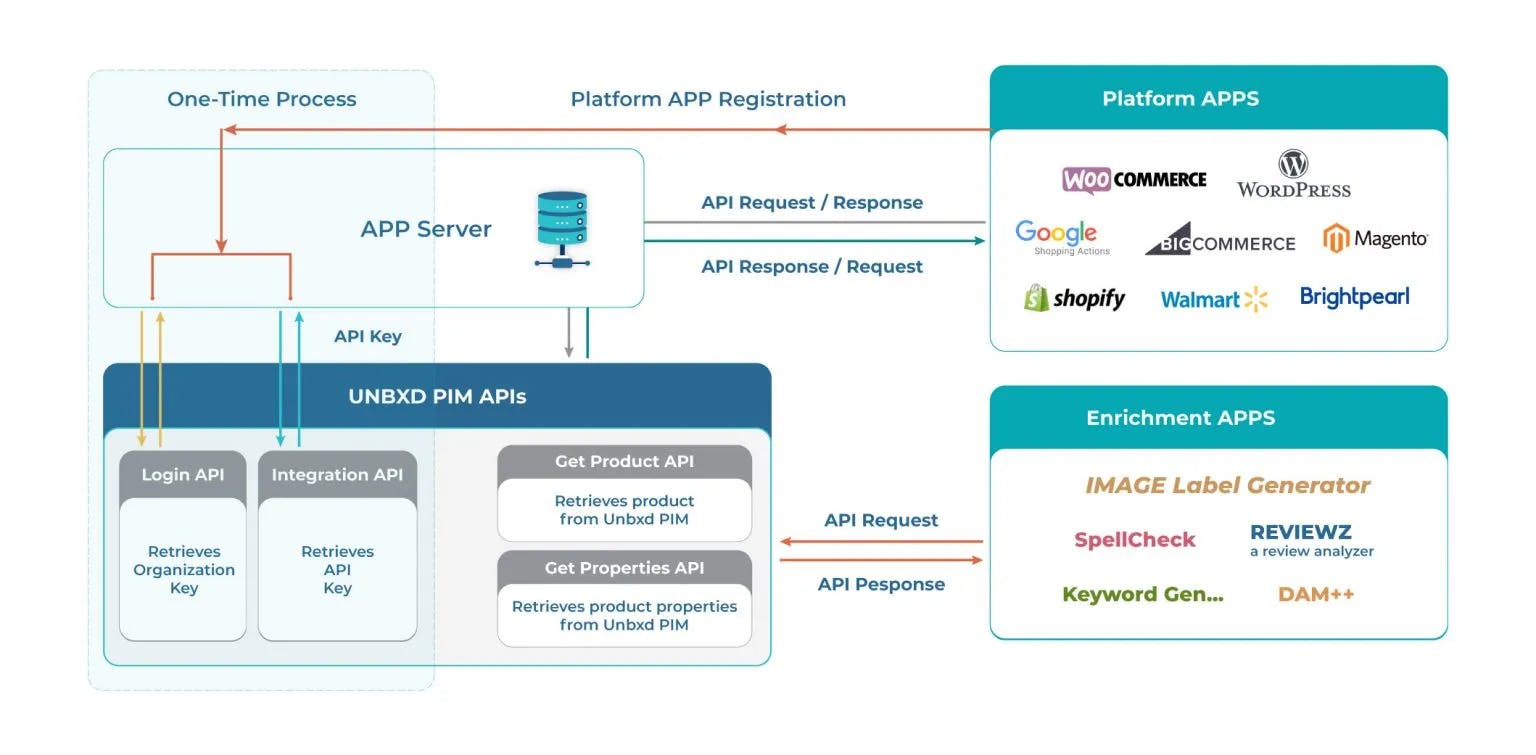What’s the challenge?
Let's look into real-life scenarios where the business needs to send impromptu changes to the catalog system. Or there is a need to update or sync the content post, which content curation and syndication will have to happen in the business systems in production. These 3rd party systems or services talk in different languages (syntax), and it is hard to crack them and make them talk to each other smoothly and with zero errors.
Similarly, imagine a scenario where a business needs to update or notify about the changes in the product catalog to multiple stakeholders or 3rd party services where product information is stored for various purposes. Again, this to-fro of the data can become quite complex if not appropriately maneuvered.
This is where Unbxd PIM APIs can come in handy. They make this integration and journey smooth and hassle-free for developers, category managers, and content teams.
What do Unbxd PIM APIs solve for?
Unbxd PIM APIs will enable businesses to cater to all business needs (as discussed above) on our platform.
- Accept catalog content from different systems using pre-authorized PIM API tokens to directly synchronize real-time inventory, pricing, or any other catalog content to the Unbxd PIM system. Once the file is received using the API key through Import APIs, Unbxd PIM can import and run a pre-configured Workflow to ingest and process the data. (Read more on Automating manual workflows using Unbxd PIM).
- To automatically pull data at regular intervals or manually from the 3rd party systems and automate the ingestion process. Using this method, we can enable the PIM Users to request data sync or update on a need basis or basis predefined agreements with the systems.
- To send data to different end systems in desired formats. This enables the businesses to curate and defines which catalog content to be sent to which system for different purposes. These use cases where the data needs to be synced to ERP systems or Inventory management systems periodically.
- Let's take another example: the catalog content needs to be sent to a 3rd party App for catalog extraction, curation, enrichment, translation to multiple languages, or a simple update. The business user can define what goes out of the system and how. So there is absolute ease concerning permission management, preventing sensitive content from going out of the systems. Using this mechanism, businesses can expand and take the help of multiple 3rd party Apps and plugins which possess the expertise to cater to specific business needs and are crucial for enhancing the overall catalog quality.
- Pull data from external systems as needed using a pre-configured catalog format via adapters. The business can also provide access to external companies to pull the catalog content in a predefined format per the companies' guidelines to make the catalog content more accurate and useful.
How does a Unbxd PIM API work?
The integration can happen between Unbxd PIM and an eCommerce platform like Big Commerce or any 3rd party system for specific business needs with PIM APIs. Successful integration can mean seamless connectivity and bidirectional product information transfer between the PIM system and these platform-powered websites or eCommerce stores.
Using the API keys wrt each Private or Public App, the PIM business user can define the subset or format of the catalog that must be accessible to the external system. The app can have a configuration to import, export, or both per the use case. The same app can also act as a purely private app that caters to the business needs of its own and where the business can use PIM as a source of truth and for catalog content transformation. It becomes easier for these integrated apps to get the data in predefined format post-validation checks. Thus, keeping all the rules and checks managed in one place.
Also, the business user can use Unbxd PIM Workflows to automate syncing between all these Apps. Businesses can configure workflows based on time or events. And using the Channel App Adapters, the catalog definition can be completely customized and formatted into multiple business requirements.

PIM API use cases
Let's deep dive into typical use cases where PIM is the single source of truth and communicates with various systems needed to run an ecommerce store end-to-end.
The use cases can be infinite, for example:
- Ability to integrate with irreplaceable native or legacy systems to quickly give them a facelift with a modern cloud-based SaaS architecture with enhanced capabilities
- External PIM APIs can be formatted outside Unbxd PIM for complex catalog formats that are not supported yet and then imported into Unbxd PIM using Import Channel APIs.
- Ability to extract keywords and tags from Images related to each product
- A system that can translate the catalog content to different languages and get it ingested into PIM using simple Import trigger APIs. It must pass the new catalog feed as XLS, JSON, XML (also Zipped), and its API key. This is then reviewed by the designated user in the system and finally synced to the end-user site.
- A spell checker module can pull catalog content, validate and then sync it back to the system.
- Custom-built AI/ML models to extract and enrich catalog content specifically modeled for different Categories and verticals.
- Gauge the popularity or ranking of the catalog content based on reviews and other analytical data captured in different systems to manage the ranking of the products.
- Inspect the content using custom tools and widgets for forecasting trends.
Business impact produced by Unbxd PIM APIs
Unbxd PIM will be a source of truth for all integration purposes with Unbxd Search. As a result, the business can easily integrate its existing system and enable them to manage the company's integrations with 3rd party systems that are critical for scaling up.
We already have integration with key marketplaces and ERP systems such as BigCommerce, Brightpearl, Amazon (Coming soon), and several other custom-built integrations with the native ERP systems of the customers using Unbxd PIM APIs.
As we look into the real-world use cases for different businesses and verticals. So one system cannot cater to all. We build a platform that can manage the source of truth for all catalog-related purposes with advanced roles, user access control, and a defined maker checker model in place.
Therefore, Unbxd PIM enables businesses to expand, integrate, and build custom solutions for varying needs while maintaining a coherent and streamlined process.
For detailed API documentation, read here.






